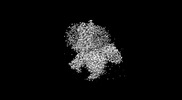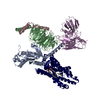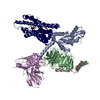登録情報 データベース : EMDB / ID : EMD-25726タイトル Structure of the human FPR2-Gi complex with compound C43 FPR2C43 複合体 : formylpeptide receptors FPR2 WITH FMLFIIタンパク質・ペプチド : Guanine nucleotide-binding protein G(i) subunit alpha-1タンパク質・ペプチド : Guanine nucleotide-binding protein G(I)/G(S)/G(T) subunit beta-1タンパク質・ペプチド : Guanine nucleotide-binding protein G(I)/G(S)/G(O) subunit gamma-2タンパク質・ペプチド : scFv16タンパク質・ペプチド : N-formyl peptide receptor 2リガンド : N-(4-chlorophenyl)-N'-[1-methyl-3-oxo-2-phenyl-5-(propan-2-yl)-2,3-dihydro-1H-pyrazol-4-yl]urea機能・相同性 分子機能 ドメイン・相同性 構成要素
/ / / / / / / / / / / / / / / / / / / / / / / / / / / / / / / / / / / / / / / / / / / / / / / / / / / / / / / / / / / / / / / / / / / / / / / / / / / / / / / / / / / / / / / / / / / / / / / / / / / / / / / / / / / / / / / / / / / / / / / / / / / / / / / / / / / / / / / / / / / / / / / / / / / / / / / 生物種 Homo sapiens (ヒト) / Rattus (ネズミ) / Bos taurus (ウシ)手法 / / 解像度 : 3.0 Å Zhuang YW 資金援助 Organization Grant number 国 National Institutes of Health/National Institute of General Medical Sciences (NIH/NIGMS) R35GM128641
ジャーナル : Nat Commun / 年 : 2022タイトル : Molecular recognition of formylpeptides and diverse agonists by the formylpeptide receptors FPR1 and FPR2.著者 : Youwen Zhuang / Lei Wang / Jia Guo / Dapeng Sun / Yue Wang / Weiyi Liu / H Eric Xu / Cheng Zhang / 要旨 : The formylpeptide receptors (FPRs) mediate pattern recognition of formylated peptides derived from invading pathogens or mitochondria from dead host cells. They can also sense other structurally ... The formylpeptide receptors (FPRs) mediate pattern recognition of formylated peptides derived from invading pathogens or mitochondria from dead host cells. They can also sense other structurally distinct native peptides and even lipid mediators to either promote or resolve inflammation. Pharmacological targeting of FPRs represents a novel therapeutic approach in treating inflammatory diseases. However, the molecular mechanisms underlying FPR ligand recognition are elusive. We report cryo-EM structures of G-coupled FPR1 and FPR2 bound to a formylpeptide and G-coupled FPR2 bound to two synthetic peptide and small-molecule agonists. Together with mutagenesis data, our structures reveal the molecular mechanism of formylpeptide recognition by FPRs and structural variations of FPR1 and FPR2 leading to their different ligand preferences. Structural analysis also suggests that diverse FPR agonists sample a conserved activation chamber at the bottom of ligand-binding pockets to activate FPRs. Our results provide a basis for rational drug design on FPRs. 履歴 登録 2021年12月14日 - ヘッダ(付随情報) 公開 2022年3月30日 - マップ公開 2022年3月30日 - 更新 2022年10月19日 - 現状 2022年10月19日 処理サイト : RCSB / 状態 : 公開
すべて表示 表示を減らす
 データを開く
データを開く 基本情報
基本情報
 マップデータ
マップデータ 試料
試料 機能・相同性情報
機能・相同性情報 Homo sapiens (ヒト) /
Homo sapiens (ヒト) / 

 データ登録者
データ登録者 米国, 1件
米国, 1件  引用
引用 ジャーナル: Nat Commun / 年: 2022
ジャーナル: Nat Commun / 年: 2022

 構造の表示
構造の表示 ダウンロードとリンク
ダウンロードとリンク emd_25726.map.gz
emd_25726.map.gz EMDBマップデータ形式
EMDBマップデータ形式 emd-25726-v30.xml
emd-25726-v30.xml emd-25726.xml
emd-25726.xml EMDBヘッダ
EMDBヘッダ emd_25726.png
emd_25726.png http://ftp.pdbj.org/pub/emdb/structures/EMD-25726
http://ftp.pdbj.org/pub/emdb/structures/EMD-25726 ftp://ftp.pdbj.org/pub/emdb/structures/EMD-25726
ftp://ftp.pdbj.org/pub/emdb/structures/EMD-25726 emd_25726_validation.pdf.gz
emd_25726_validation.pdf.gz EMDB検証レポート
EMDB検証レポート emd_25726_full_validation.pdf.gz
emd_25726_full_validation.pdf.gz emd_25726_validation.xml.gz
emd_25726_validation.xml.gz emd_25726_validation.cif.gz
emd_25726_validation.cif.gz https://ftp.pdbj.org/pub/emdb/validation_reports/EMD-25726
https://ftp.pdbj.org/pub/emdb/validation_reports/EMD-25726 ftp://ftp.pdbj.org/pub/emdb/validation_reports/EMD-25726
ftp://ftp.pdbj.org/pub/emdb/validation_reports/EMD-25726 リンク
リンク EMDB (EBI/PDBe) /
EMDB (EBI/PDBe) /  EMDataResource
EMDataResource マップ
マップ ダウンロード / ファイル: emd_25726.map.gz / 形式: CCP4 / 大きさ: 30.5 MB / タイプ: IMAGE STORED AS FLOATING POINT NUMBER (4 BYTES)
ダウンロード / ファイル: emd_25726.map.gz / 形式: CCP4 / 大きさ: 30.5 MB / タイプ: IMAGE STORED AS FLOATING POINT NUMBER (4 BYTES) 試料の構成要素
試料の構成要素 Homo sapiens (ヒト)
Homo sapiens (ヒト) Homo sapiens (ヒト)
Homo sapiens (ヒト) Spodoptera (蝶・蛾)
Spodoptera (蝶・蛾)
 Spodoptera (蝶・蛾)
Spodoptera (蝶・蛾)
 Spodoptera (蝶・蛾)
Spodoptera (蝶・蛾)
 Spodoptera (蝶・蛾)
Spodoptera (蝶・蛾) Homo sapiens (ヒト)
Homo sapiens (ヒト) Spodoptera (蝶・蛾)
Spodoptera (蝶・蛾)
 解析
解析 試料調製
試料調製 電子顕微鏡法
電子顕微鏡法 FIELD EMISSION GUN
FIELD EMISSION GUN
 画像解析
画像解析 ムービー
ムービー コントローラー
コントローラー


































